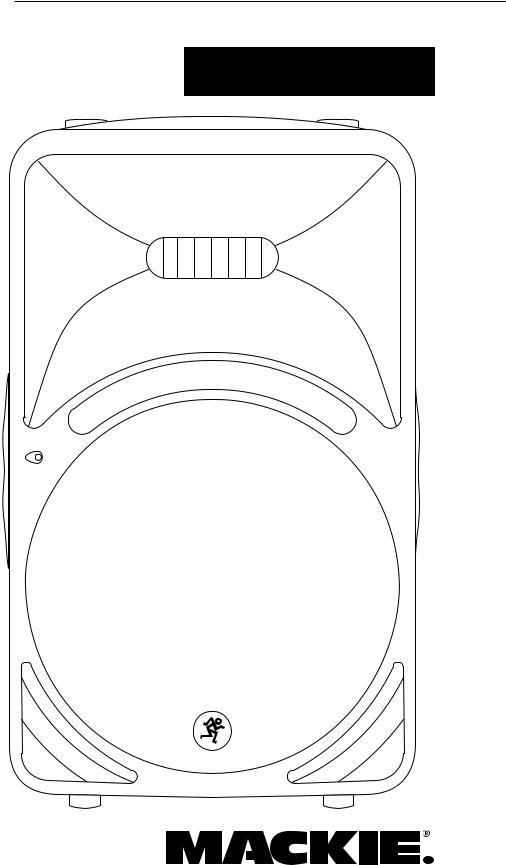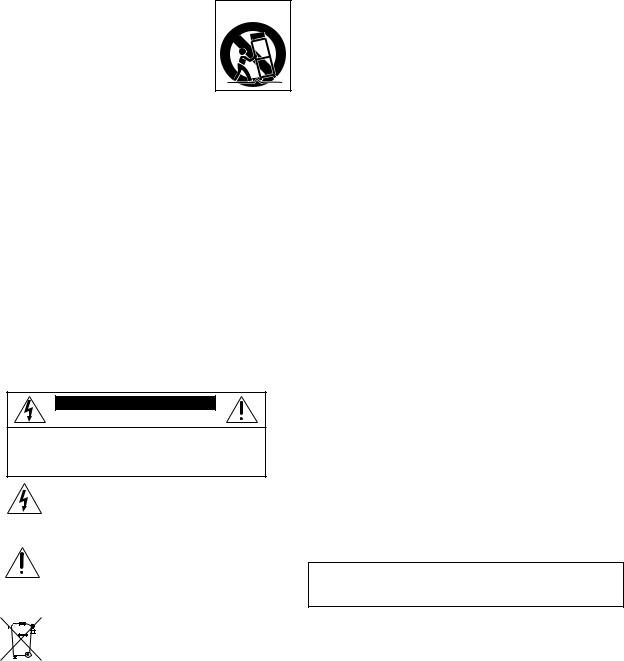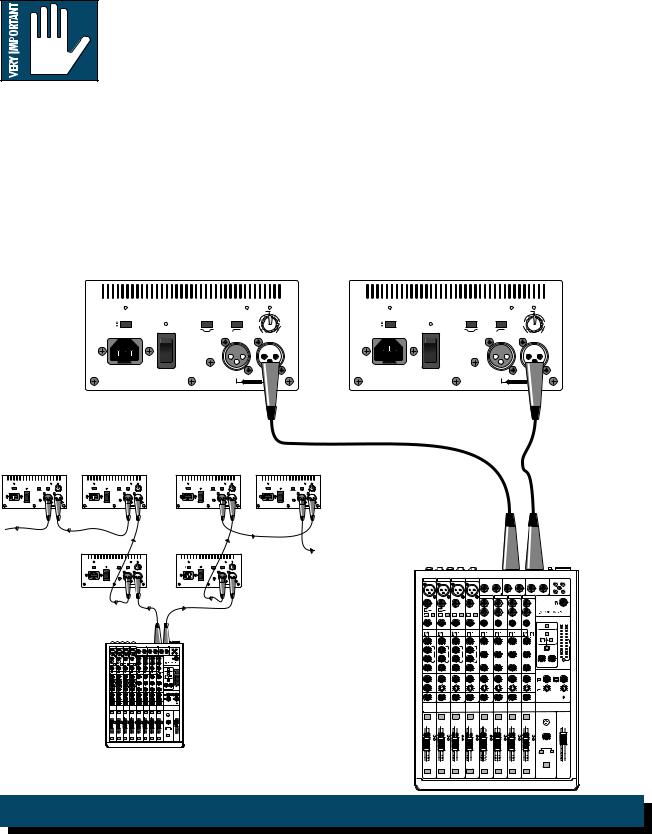Mackie SRM450V2 User Manual

SRM450v2
Powered Loudspeaker
OWNER’S MANUAL

IMPORTANT SAFETY INSTRUCTIONS
1.Read these instructions.
2.Keep these instructions.
3.Heed all warnings.
4.Follow all instructions.
5.Do not use this apparatus near water.
6.Clean only with a dry cloth.
7.Do not block any ventilation openings. Install in accordance with the manufacturer’s instructions.
8.Do not install near any heat sources such as radiators, heat registers, stoves, or other apparatus (including amplifiers) that produce heat.
9.Do not defeat the safety purpose of the polarized or grounding-type plug. A polarized plug has two blades with one wider than the other. A grounding-type plug has two blades and a third grounding prong. The wide blade or the third prong are provided for your safety. If the provided plug does not fit into your outlet, consult an electrician for replacement of the obsolete outlet.
10.Protect the power cord from being walked on or pinched particularly at plugs, convenience receptacles, and the point where they exit from the apparatus.
11.Only use attachments/accessories specified by the manufacturer.
12. Use only with a cart, stand, tripod, bracket, or table specified by the manufacturer, or sold with the apparatus. When a cart is used, use caution when moving the cart/apparatus combination to avoid injury from tip-over.
13. Unplug this apparatus during lightning storms or when unused for long periods of time.
14.Refer all servicing to qualified service personnel. Servicing is required when the apparatus has been damaged in any way, such as powersupply cord or plug is damaged, liquid has been spilled or objects have fallen into the apparatus, the apparatus has been exposed to rain or moisture, does not operate normally, or has been dropped.
15.This apparatus shall not be exposed to dripping or splashing, and no object filled with liquids, such as vases or beer glasses, shall be placed on the apparatus.
16.Do not overload wall outlets and extension cords as this can result in a risk of fire or electric shock.
17.This apparatus has been designed with Class-I construction and must be connected to a mains socket outlet with a protective earthing connection (the third grounding prong).
18.This apparatus has been equipped with a rocker-style AC mains power switch. This switch is located on the rear panel and should remain readily accessible to the user.
19.The MAINS plug or an appliance coupler is used as the disconnect device, so the disconnect device shall remain readily operable.
CAUTION AVIS
RISK OF ELECTRIC SHOCK. DO NOT OPEN
RISQUE DE CHOC ELECTRIQUE. NE PAS OUVRIR
CAUTION: TO REDUCE THE RISK OF ELECTRIC SHOCK DO NOT REMOVE COVER (OR BACK) NO USER-SERVICEABLE PARTS INSIDE. REFER SERVICING TO QUALIFIED PERSONNEL
ATTENTION: POUR EVITER LES RISQUES DE CHOC ELECTRIQUE, NE PAS ENLEVER LE COUVERCLE.
AUCUN ENTRETIEN DE PIECES INTERIEURES PAR L'USAGER.
CONFIER L'ENTRETIEN AU PERSONNEL QUALIFIE.
AVIS: POUR EVITER LES RISQUES D'INCENDIE OU D'ELECTROCUTION, N'EXPOSEZ PAS CET ARTICLE
A LA PLUIE OU A L'HUMIDITE
The lightning flash with arrowhead symbol within an equilateral triangle is intended to alert the user to the presence of uninsulated "dangerous voltage" within the product's enclosure, that may be of sufficient magnitude to constitute a risk of electric shock to persons.
Le symbole éclair avec point de flèche à l'intérieur d'un triangle équilatéral est utilisé pour alerter l'utilisateur de la présence à l'intérieur du coffret de "voltage dangereux" non isolé d'ampleur suffisante pour constituer un risque d'éléctrocution.
The exclamation point within an equilateral triangle is intended to alert the user of the presence of important operating and maintenance (servicing) instructions in the literature accompanying the appliance.
Le point d'exclamation à l'intérieur d'un triangle équilatéral est employé pour alerter les utilisateurs de la présence d'instructions importantes pour le fonctionnement et l'entretien (service) dans le livret d'instruction accompagnant l'appareil.
20.NOTE: This equipment has been tested and found to comply with the limits for a Class B digital device, pursuant to part 15 of the FCC Rules. These limits are designed to provide reasonable protection against harmful interference in a residential installation. This equipment generates, uses, and can radiate radio frequency energy and, if not installed and used in accordance with the instructions, may cause harmful interference to radio communications. However, there is no guarantee that interference will not occur in a particular installation.
If this equipment does cause harmful interference to radio or television reception, which can be determined by turning the equipment off and on, the user is encouraged to try to correct the interference by one or more of the following measures:
•Reorient or relocate the receiving antenna.
•Increase the separation between the equipment and the receiver.
•Connect the equipment into an outlet on a circuit different from that to which the receiver is connected.
•Consult the dealer or an experienced radio/TV technician for help.
CAUTION: Changes or modifications to this device not expressly approved by LOUD Technologies Inc. could void the user's authority to operate the equipment under FCC rules.
21.This apparatus does not exceed the Class A/Class B (whichever is applicable) limits for radio noise emissions from digital apparatus as set out in the radio interference regulations of the Canadian Department of Communications.
ATTENTION — Le présent appareil numérique n’émet pas de bruits radioélectriques dépassant las limites applicables aux appareils numériques de class A/de class B (selon le cas) prescrites dans le réglement sur le brouillage radioélectrique édicté par les ministere des communications du Canada.
22.Exposure to extremely high noise levels may cause permanent hearing loss. Individuals vary considerably in susceptibility to noise-induced hearing loss, but nearly everyone will lose some hearing if exposed to sufficiently intense noise for a period of time. The U.S. Government’s Occupational Safety and Health Administration (OSHA) has specified the permissible noise level exposures shown in the following chart. According to OSHA, any exposure in excess of these permissible limits could result in some hearing loss. To ensure against potentially dangerous exposure to high sound pressure levels, it is recommended that all persons exposed to equipment capable of producing high sound pressure levels use hearing protectors while the equipment is in operation. Ear plugs or protectors in the ear canals or over the ears must be worn when operating the equipment in order to prevent permanent hearing loss if exposure is in excess of the limits set forth here:
Duration, per |
Sound Level dBA, |
Typical Example |
|
day in hours |
Slow Response |
||
|
|||
|
|
|
|
8 |
90 |
Duo in small club |
|
6 |
92 |
|
|
4 |
95 |
Subway Train |
|
3 |
97 |
|
|
2 |
100 |
Very loud classical music |
|
1.5 |
102 |
|
|
1 |
105 |
Adrian screaming at Troy & Jayme about deadlines |
|
0.5 |
110 |
|
|
0.25 or less |
115 |
Loudest parts at a rock concert |
WARNING — To reduce the risk of fire or electric shock, do not expose this apparatus to rain or moisture.
|
|
|
|
|
|
|
|
|
Correct Disposal of this product: This symbol indicates that this product should not be disposed of with your household waste, according to the WEEE Directive |
|
|
|
|
|
|
|
|
|
(2002/96/EC) and your national law. This product should be handed over to an authorized collection site for recycling waste electrical and electronic equipment (EEE). Improper handling |
|
|
|
|
|
|
|
|
|
of this type of waste could have a possible negative impact on the environment and human health due to potentially hazardous substances that are generally associated with EEE. At the |
2 |
|
|
|
|
|
|
|
|
same time, your cooperation in the correct disposal of this product will contribute to the effective usage of natural resources. For more information about where you can drop off your waste |
|
|
|
|
|
|
|
|
equipment for recycling, please contact your local city office, waste authority, or your household waste disposal service. |
|
|
|
|
|
|
|
|
|||
|
|
|
|
|
|
|
|
|
|

Contents
IMPORTANT SAFETY INSTRUCTIONS........................................ |
2 |
CONNECTIONS...................................................................... |
10 |
INTRODUCTION....................................................................... |
4 |
PLACEMENT........................................................................... |
10 |
HOOKUP DIAGRAMS............................................................... |
6 |
Room Acoustics.............................................................. |
10 |
Quick Start....................................................................... |
6 |
RIGGING............................................................................... |
11 |
REAR PANEL DESCRIPTION....................................................... |
8 |
THERMAL CONSIDERATIONS.................................................. |
12 |
1. IEC Socket.................................................................... |
8 |
AC POWER CONSIDERATIONS............................................... |
12 |
2. POWER Switch............................................................. |
8 |
AC Power Distribution.................................................... |
12 |
3. POWER ON Indicator................................................... |
8 |
SERVICE INFORMATION......................................................... |
14 |
4. TIMED TURNOFF........................................................... |
8 |
Troubleshooting............................................................. |
14 |
5. THERMAL Indicator....................................................... |
8 |
Repair............................................................................ |
16 |
6. CONTOUR.................................................................... |
8 |
CARE AND MAINTENANCE.................................................... |
16 |
7. LOW CUT...................................................................... |
8 |
SPECIFICATIONS..................................................................... |
17 |
8. LEVEL............................................................................ |
9 |
BLOCK DIAGRAM................................................................... |
18 |
9. SIGNAL PRESENT Indicator........................................... |
9 |
LIMITED WARRANTY.............................................................. |
19 |
10. PEAK Indicator........................................................... |
9 |
|
|
11. INPUT Connector........................................................ |
9 |
|
|
12. THRU Connector......................................................... |
9 |
|
|
Please write the serial number for your SRM450v2 here
(or for both SRM450v2s if you have two) for future reference (i.e., insurance claims, tech support, return authorization, etc.):
Loudspeaker 1 |
|
Loudspeaker 2 |
|
|
|
|
|
|
Purchased at:___________________________________ Date of Purchase:_____________
Don’t forget to visit our website at www.mackie.com for more information about this and other Mackie products.
Part No. SW0617 Rev. E 03/11 |
3 |
©2007-2011 LOUD Technologies Inc. All Rights Reserved. |

INTRODUCTION
Thank you for choosing LOUD Technologies’ Mackie active sound reinforcement loudspeakers.
The SRM450v2 is a redesigned version of our popular SRM450 active loudspeaker. With its newly designed Class-D Fast-Recovery amplifiers, high-output compression driver, and 12" woofer, it produces an even smoother sound than the original. SRM means Sound
Reinforcement Monitor, and the SRM450v2 truly produces a studio quality sound in a sound reinforcement speaker.
Our design goal was to build a sound reinforcement speaker with:
1.High precision, high output, and accurate playback.
2.Very wide, smooth dispersion of mid and high frequencies.
3.Ergonomically correct physical design for easy transport and set up.
Through the combined resources of our top-notch mechanical and analog engineers, and our experienced transducer engineers at EAW, we were able to achieve our design goals in every aspect. The result is a sound reinforcement system equally at home in a concert setting, in the studio, impromptu concerts on the studio roof, in the cinema, or in a home theater.
The Transducers
The SRM450v2 active speakers feature a 12-inch highpower low-frequency woofer with a 3-inch voice coil and a 1.75-inch titanium diaphragm high-output compression driver. This high-frequency driver is mounted on an
acoustically non-resonant exponential waveguide, providing a wide, controlled dispersion and precise reproduction of the critical upper mid-range and high frequencies. The result is an unbelievably smooth off-axis response that allows everyone in the audience to experience the same high-resolution audio no matter where they are seated.
The Power Amplifiers
To power these beauties, each SRM450v2 includes two of our acclaimed FR Series “Fast Recovery” power amplifiers. In addition, the low-frequency amplifier uses a Class D design for improved efficiency and cleaner power. Our exclusive designs use low negative feedback, yet allow the amplifiers to maintain low distortion and stability and to quickly recover when driven into clipping.
The amplifiers include the following features:
•The low-frequency amplifier produces up to 540 watts peak (300 continuous) before clipping.
•The high-frequency amplifier produces up to 150 watts peak (100 continuous) before clipping.
•Each amplifier has its own compressor circuit that acts when the input signal is large enough to cause clipping, distortion and excessive voice coil heat. The compressor will automatically decrease the input signal to a safe level. The compressor in the low-frequency amp works independently from that in the high-frequency amp.
•Thelow-frequencyampusesaservofeedbackloop which senses the current flowing in the woofer coil. This controls the low-frequency response and maintains low distortion at high output levels.
•The low-frequency amplifier also has a sweeping filter.
This will automatically move the low cut-off frequency up or down depending on the amplifier output. For example, if the amplifier is below clipping, the low-frequency cutoff point is 55 Hz. As it approaches clipping, this shifts up smoothly to 120 Hz, providing more power reserves and less distortion before clipping. This happens quickly and continuously, protecting the amplifier and the woofer and reducing any noticeable distortion.
Warning: Although the amplifiers have
these protection circuits, you must still
make sure the PEAK light is not blinking
continuously. If it is, turn down your
mixer faders, or preamplifier gain, or turn down the SRM450v2 LEVEL control.
The Crossover
The built-in electronic crossover is a 24 dB/octave Linkwitz-Riley design. Although more expensive than other crossover designs, the benefits provided by the LinkwitzRiley design have been well documented. These benefits include:
•Absolutely flat frequency response throughout the bandpass, without the characteristic ripple near the crossover point exhibited by other designs.
•The sharp 24 dB per octave roll-off of the filters ensures that the transducers aren’t reproducing frequencies outside of their capabilities.
•The acoustic sum of the two driver responses is unity at the crossover frequency, resulting in perfect power response.
•Our heroic engineers have worked carefully to ensure that the SRM450v2 also provides perfect phase response. This diligence has yielded phenomenal accuracy, even if you are standing 20 feet away.
4

The Cabinet
The SRM450v2 cabinet was designed to be the strongest molded composite cabinet on the planet. This material is as strong as concrete, and rigid enough to prevent unwanted vibrations in the cabinet. It has built-in fly points for hanging, and a socket in the bottom for mounting on a tripod stand. Although it is an exceptional choice for installed sound situations, its light weight and durable finish also make it ideal for portable sound system use. The asymmetrical trapezoidal design of the cabinet makes it easy to use as a floor wedge for stage monitor applications.
The Active Advantage
There are a number of advantages to using an active speaker system over a passive loudspeaker:
•The internal crossover is active, and its low power circuitry operates on line-level signals. It does not waste speaker-level power like a passive crossover with large coils, caps, and resistors.
•The input signals are crossed over before they reach the amplifiers, so each amplifier only receives the correct frequency range for its driver.
•The amplifiers are designed specifically for these speaker load impedances. There is no guesswork as to what load each amplifier has to drive, so they can provide maximum acoustic output from the speakers, yet minimize the danger of speaker damage due to overdriving a lesser amplifier.
•The connecting wires between the amplifier outputs and the drivers are kept to a minimum, so the damping factor of the amplifier isn’t compromised by the resistance of long speaker cables. In addition, all the power from the amplifier is transferred directly to the drivers with no speaker cable losses.
•The acoustic sum of the outputs from the two drivers is optimized electronically, as well as physically, so the amplitude response is flat and there is no lobing error.
•The presence of active circuits within the speaker cabinet allow the designer to add on extra details, such as a high quality mic/line input section.
In short, all the complex interconnected components in the system are designed to work in harmony with each other to produce the best possible sound. (Even for Uncle Bert’s star performance on spoons!)
5

HOOKUP DIAGRAMS
Quick Start
1.Start with the following settings on the back of the SRM450v2:
Turn the POWER switch off (down).
Set the TIMED TURNOFF, CONTOUR, and LOW CUT switches out.
WARNING: Turn the LEVEL control down (counterclockwise) before every use. If not, you could be in for a startling surprise, especially if the last time you used it was with a microphone and now you want to connect a line-level source.
2.Connect the output from your signal source (mixing console, microphone, preamp, or other micor line-level source) directly to the INPUT connector on the back of the SRM450v2. It accepts balanced line-level signals from mixers, preamplifiers, CD players, tape decks, etc., and accepts direct connections from dynamic microphones.
3.Connect the supplied AC power cord to the IEC socket on the back of the SRM450v2. Plug the other end into an AC outlet properly configured with the correct voltage for your particular model.
4.Turn on your signal source. Make sure its Master Volume control (if it has one) is turned all the way down.
5.Turn on the SRM450v2 POWER switch.
6.Start the signal source, whether it be speaking into a microphone or starting a CD player. Adjust any volume controls on the signal source for normal operation.
7.Slowly turn up the LEVEL control on the back of the SRM450v2 until the desired volume is reached (and the PEAK light does not come on) Always wear hearing protectors if you are close when it is playing at high levels.
8.If there is no sound, always turn down the SRM450v2 LEVEL control before investigating. There may be a mixer or preamplifier mute or tape switch engaged, or a mic switch off.
THERMAL |
PEAK |
SIGNAL PRESENT |
|
|
|
|
NORMAL |
|
|
|
|
|
(+4dBu) |
|
ON |
POWER |
|
|
LINE |
MIC |
|
|
|
|||
OFF |
|
|
|
|
|
TIMED TURNOFF |
|
100Hz |
12k/AIR |
75Hz |
OO +40dB |
|
ON |
CONTOUR +3dB |
LOW CUT |
LEVEL |
|
O
THRU
PARALLE
THERMAL |
PEAK |
SIGNAL PRESENT |
|
|
|
|
NORMAL |
|
|
|
|
|
(+4dBu) |
|
ON |
POWER |
|
|
LINE |
MIC |
|
|
|
|||
OFF |
|
|
|
|
|
TIMED TURNOFF |
|
100Hz |
12k/AIR |
75Hz |
OO +40dB |
|
ON |
CONTOUR +3dB |
LOW CUT |
LEVEL |
|
O
THRU
PARALLE
Next |
From Mixer |
|
|
|
From Mixer |
||||
|
Left Output |
|
|
|
Right Output |
||||
|
Next |
|
|
|
|
|
|
|
|
|
1 |
2 |
3 |
4 |
CTRL - RM OUT |
MAIN OUT |
ALT 3-4 OUT |
TAPE |
|
Thru |
Thru |
|
|
|
|
|
|
IN |
OUT |
|
|
|
LINE IN 5-6 |
LINE IN 7-8 |
LINE IN 9-10 |
LINE IN 11-12 |
|
||
|
|
|
|
|
L |
R |
L R |
L/3 R/4 |
|
|
1 |
2 |
3 |
4 |
L |
L |
L |
L |
|
|
LINE |
LINE |
LINE |
LINE |
|
|
|
|
|
From Mixer |
From Mixer |
|
|
|
|
R |
R |
R |
R |
|
|
|
|
|
|
|
|
|
|
CTRL ROOM/PHONES |
Mixing Console |
||
|
|
|
|
|
|
|
|
|
|
SOURCE |
|
|
|
|
|
|
|
|
|
|
|
L R |
|
Left Output |
Right Output |
EQ |
EQ |
EQ |
EQ |
EQ |
EQ |
EQ |
|
|
(Mackie Onyx |
|
|
HIGH |
HIGH |
HIGH |
HIGH |
HIGH |
HIGH |
HIGH |
HIGH |
|
|
|
|
MID |
MID |
MID |
MID |
MID |
MID |
MID |
MID |
|
1220i shown) |
|
|
|
|
|
|
|
|
|
|
CONTROL PHONES |
|
|
|
|
|
|
|
|
|
|
|
ROOM |
|
|
|
LOW |
LOW |
LOW |
LOW |
LOW |
LOW |
LOW |
LOW |
|
|
|
|
|
|
|
|
|
|
|
|
AUX MASTER |
|
|
|
AUX |
AUX |
AUX |
AUX |
AUX |
AUX |
AUX |
AUX |
|
|
|
|
1 |
1 |
1 |
1 |
1 |
1 |
1 |
1 |
1 |
1 |
2  2
2  2
2  2
2  2
2  2
2  2
2  2
2 
 2
2 
 2
2
PAN  PAN
PAN  PAN
PAN  PAN
PAN  PAN
PAN  PAN
PAN  PAN
PAN  PAN
PAN
|
MUTE |
MUTE |
MUTE |
MUTE |
MUTE |
MUTE |
MUTE |
MUTE |
Mixing Console |
|
|
|
|
|
|
|
|
(Mackie Onyx 1220i shown) |
SOLO |
SOLO |
SOLO |
SOLO |
SOLO |
SOLO |
SOLO |
SOLO |
|
1 |
2 |
|
3 |
4 |
5-6 |
7-8 |
9-10 11-12 TALKBACK MAIN MIX |
SRM450v2: STEREO OPERATION WITH A MIXER, and using the thru jack
6
